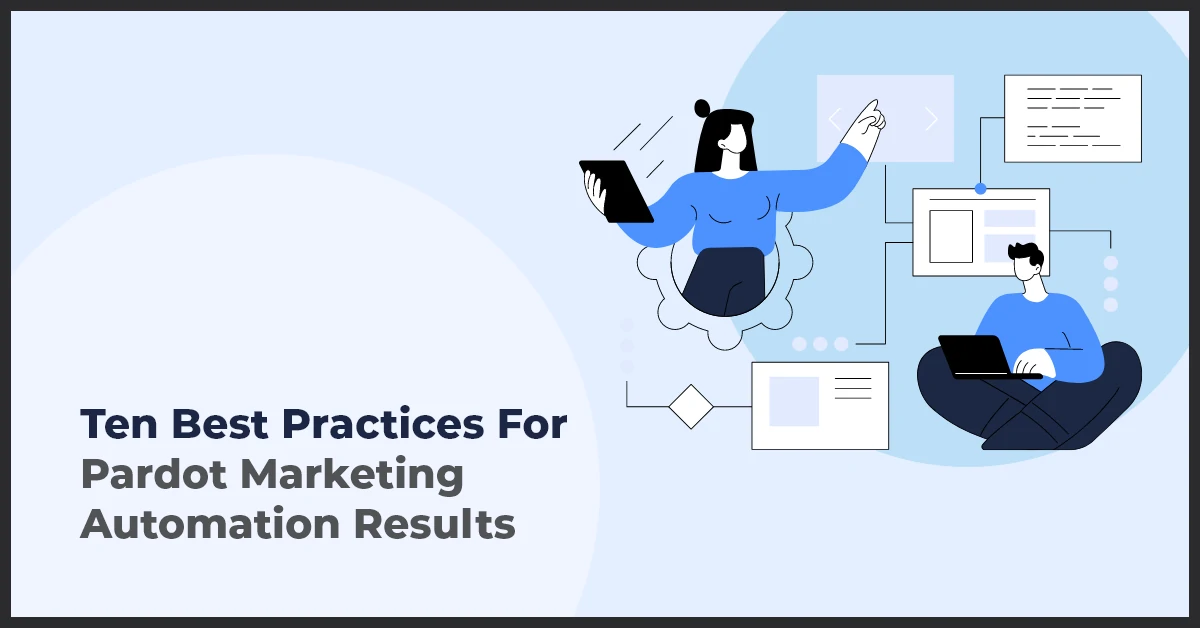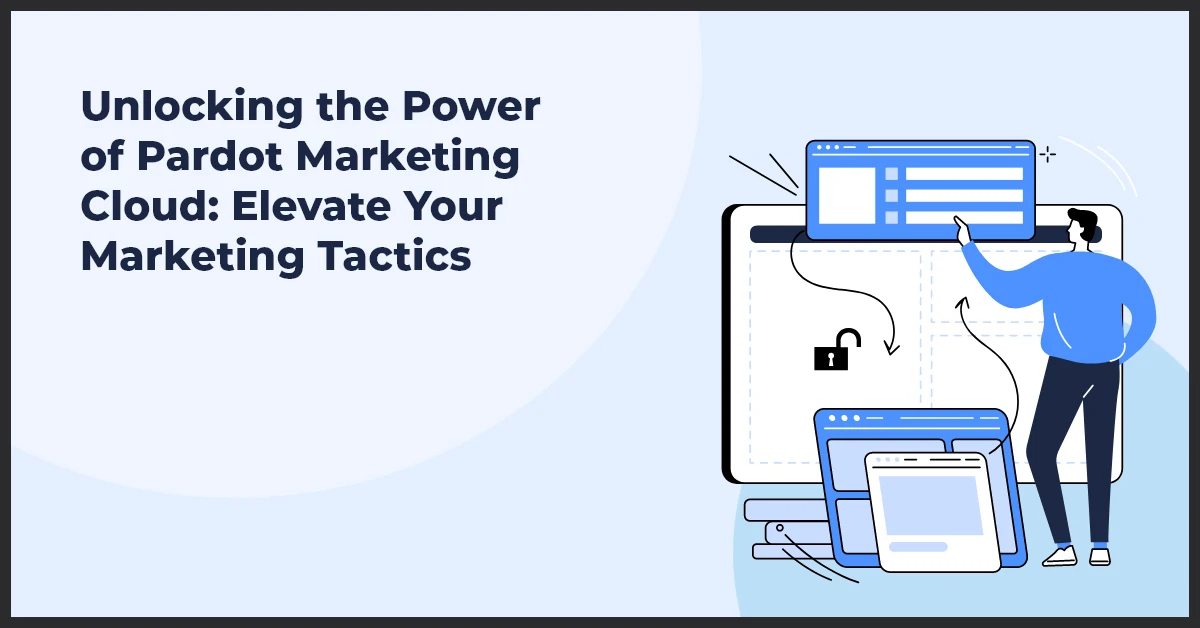10 Best Pardot Marketing Automation Practices to Boost Results

Published on: May 26, 2020
Updated on: March 07, 2025
2656 Views
- Pardot
15 min read
Today, successful businesses are leveraging marketing automation to streamline their marketing efforts and drive remarkable results. Marketing automation refers to the use of software and technology to automate repetitive marketing tasks, allowing marketers to focus on strategy, creativity, and building valuable relationships with their audience.
One leading marketing automation platform that has gained immense popularity is Pardot. Pardot offers a comprehensive suite of tools designed to simplify, enhance, and optimize marketing processes. With its advanced features, Pardot enables businesses to generate and nurture leads, personalize customer experiences, and increase revenue.
However, to truly unlock the power of Pardot and achieve exceptional marketing automation results, it's essential to follow best practices. In this article, we will explore some top tips, strategies, and techniques to maximize your Pardot marketing automation efforts and drive exceptional ROI.
What Are the Main Pardot Features?
Pardot, now known as Marketing Cloud Account Engagement, is a powerful B2B marketing automation tool by Salesforce. It helps businesses streamline lead generation, automate email marketing, and improve sales and marketing alignment. Let’s explore the key features that make Pardot an essential tool for marketing success.
What’s Included in Pardot?
1. Marketing Campaign Management
Pardot provides robust tools for creating, managing, and analyzing email campaigns, landing pages, and forms. Marketers can:
- Design and schedule Pardot email campaigns
- Use A/B testing for optimizing subject lines and content
- Track campaign performance with built-in analytics
2. Lead Nurturing
One of Pardot’s most powerful features is lead nurturing, which helps businesses engage with potential customers at every stage of their journey. With Pardot automation, you can:
- Create automated email sequences to educate and engage leads
- Score and grade leads based on their activity and fit
- Personalize email content to match user behavior
3. Integration with Salesforce
Pardot works seamlessly with Salesforce CRM, ensuring that marketing and sales teams have access to the same lead data. This integration helps:
- Sync lead activity and engagement with Salesforce records
- Automate follow-ups based on lead scores
- Enable sales teams to access marketing insights directly in Salesforce
4. Integration with Other Systems
Beyond Salesforce, Pardot integrates with many third-party tools, including:
- Google Ads for tracking paid campaign performance
- Social media platforms for automated posting and engagement
- Webinar and event management tools like Zoom and Go-To Webinar
Mastering Marketing Automation with Salesforce Pardot
To get the most out of Pardot email marketing, businesses should:
- Leverage automation to reduce manual tasks and personalize interactions
- Use dynamic content to tailor messages based on customer behavior
- Monitor campaign performance to optimize future efforts
Why is following Pardot best practices important?
Following Pardot best practices is critical to maximizing the marketing automation experience. Implementing efficient practices can save time and increase productivity. In turn, this leads to achieving and surpassing marketing objectives.
At MarCloud Consulting, we have seen the benefits of following Pardot best practices firsthand. For example, setting up naming conventions for campaigns, lists, and custom fields allows for easier navigation and organization. Additionally, establishing a suppression list ensures compliance with anti-spam laws and reduces the risk of harming the email marketing reputation.
Ultimately, following Pardot best practices is about utilizing the platform to its fullest potential. This includes creating dynamic content and lists, using engagement studio for lead nurturing, and aligning sales and marketing efforts through the sales pipeline. By doing so, the marketing team can better understand the customer journey and create relevant content that resonates with potential and prospective customers.
In short, implementing Pardot best practices is crucial to maximize the marketing automation experience and surpass marketing objectives. It is a powerful tool to streamline marketing activities, generate leads, and ultimately drive revenue. By following these practices, businesses can differentiate themselves from competitors and create a better customer experience.
What are the ten best practices for Pardot marketing automation to achieve optimal results?
The ten best practices for Pardot marketing automation include:
- Define Clear Goals: Establish specific campaign objectives to ensure alignment and measure success.
- Segment Your Audience: Use data to create targeted segments for personalized messaging and improved engagement.
- Leverage Dynamic Content: Customize content based on user behavior and preferences to enhance relevance and conversion.
- Implement Lead Scoring: Prioritize leads based on their engagement level and fit to focus efforts on high-potential prospects.
- Automate Nurturing Campaigns: Set up automated workflows to guide leads through the sales funnel with timely and relevant content.
- Utilize A/B Testing: Test different elements of your campaigns to determine what works best and optimize performance.
- Monitor and Analyze Performance: Review analytics to track results, identify trends, and adjust strategies accordingly.
- Integrate with CRM: Ensure seamless integration with your CRM to synchronize data and enhance lead management.
- Maintain Data Hygiene: Regularly clean and update your database to ensure the accuracy and effectiveness of your marketing efforts.
- Train Your Team: Provide ongoing training to ensure your team is proficient in using Pardot’s features and best practices.
Pardot Email Marketing
Pardot is a powerful marketing automation tool that allows marketers to create and send a variety of email types to their audience. These different email types include Engagement Studio, Drip programs, one-to-one emails, list emails, and autoresponders.
Engagement Studio emails are generally used in campaigns that involve a series of events or actions that a prospective customer must complete. These emails can be triggered by an action taken on a website or by a form submission. The emails sent through Engagement Studio are often personalized, and can include content specific to the recipient's interests or behaviors.
Drip programs, on the other hand, are sent automatically over a predetermined period of time. Drip emails are ideal when a marketer wants to nurture their leads and move them through the sales funnel over time. These emails can be triggered, similar to Engagement Studio, by a specific action or behavior.
One-to-one emails are personalized emails that are sent to an individual recipient. These emails are often used to follow up on a specific request or inquiry, or to offer a solution to a specific problem. These emails are highly personalized and tailored to the individual recipient.
List emails are sent to a specific list of recipients. These emails can be useful for promoting a particular product or service, or for announcing a company update or promotion. List emails can be segmented based on different criteria, such as location, industry, or job title, to ensure the content is relevant to the recipient.
Finally, autoresponders are automated emails that are sent in response to a specific event or trigger. For example, when a user subscribes to a newsletter, an autoresponder can be set up to confirm their subscription and deliver a welcome message.
When creating emails in Pardot, there are a few key considerations that marketers should keep in mind. First, audience segmentation is critical to ensuring that the right message is delivered to the right person. It's essential to understand the audience's interests, needs, and behaviors to create the most effective emails. Additionally, having clear email objectives is critical to ensuring the message is effective.
In conclusion, Pardot offers marketers a variety of email types to reach their audience. Whether using Engagement Studio, Drip programs, one-to-one emails, list emails, or autoresponders, there are many opportunities to create highly personalized and effective email campaigns. By keeping audience segmentation and email objectives in mind, marketers can maximize the power of Pardot's email marketing capabilities.
Types of Pardot emails
Pardot offers a variety of email types that can be used in email campaigns. By understanding each type of email offered by Pardot, you can create effective email campaigns that engage your target audience and drive results.
1. List Emails: These are mass emails that are sent to a particular list of recipients. List emails are perfect for sending newsletters or promotional materials. You can select a list of prospects, customers, or any other audience you want to reach.
2. Autoresponder Emails: These emails are triggered automatically when a prospect takes a specific action, such as filling out a form. Autoresponders are perfect for sending confirmation or thank-you emails, and they help nurture relationships with prospects.
3. Engagement Program Emails: These emails are delivered over a period of time as part of an automated series. Engagement programs help you deliver the right message to the right prospect at the right time, increasing the chances of conversion. Engagement emails are perfect for creating a drip campaign that delivers value over time.
4. One-to-One Emails: These emails are personalized and sent manually by a user. One-to-one emails are perfect for sending personalized messages to prospects or customers, building relationships, and increasing engagement.
5. Email Templates: These are customizable, pre-built templates that can be used for any type of email campaign. You can choose from a wide variety of templates to create visually appealing and effective emails that drive engagement and results.
In conclusion, Pardot offers a variety of email types that can be used to create effective email campaigns. Whether you're looking to nurture relationships with prospects or customers, deliver value over time, or send personalized messages, Pardot has the right email type for your needs. By utilizing the different email types, you can create successful campaigns that drive engagement, increase conversions, and ultimately drive business growth.
Maximizing Email Marketing Results with Pardot
Email Design Best Practices for Increased Engagement
When it comes to email marketing, design plays a crucial role in capturing the attention of your audience. To maximize engagement with your emails in Pardot, consider the following best practices:
- Use eye-catching visuals and a clean, mobile-responsive layout to ensure your emails look great on any device.
- Include clear and compelling subject lines that entice recipients to open your emails.
- Keep your email content concise and easily scannable, while also using formatting to emphasize key points.
Implementing Personalization and Segmentation Strategies
Personalization and segmentation are powerful strategies for improving the effectiveness of your email campaigns with Pardot. Here are some best practices to implement:
- Collect relevant data from prospects and use it to personalize your emails with dynamic content.
- Segment your email lists based on characteristics such as demographics, behavior, and engagement levels.
- Craft tailored messages that resonate with each segment, addressing their specific needs and interests.
A/B Testing Tactics to Optimize Email Performance
A/B testing allows you to optimize your email marketing efforts by comparing different versions of the same email. Consider these tactics for effective A/B testing:
- Test various elements such as subject lines, call-to-action buttons, images, and email copy to identify the most effective combination.
- Make sure to test one element at a time to accurately measure its impact on your email’s performance.
- Analyze the results of your A/B tests and iterate on your findings to continuously improve your email marketing strategy.
Enhancing Email Deliverability through Proper Setup and Targeting
Email deliverability is crucial for the success of your marketing campaigns. To improve deliverability in Pardot, follow these best practices:
- Ensure your sender reputation is strong by using a recognized sender domain and avoiding spam trigger words and phrases.
- Regularly monitor and maintain your email lists to remove inactive or unsubscribed contacts.
- Segment your lists to send relevant and targeted emails, reducing the likelihood of being marked as spam.
He is stating the obvious, yet underlining the essence of marketing automation when Ramsay Leimenstoll says of email marketing, “A small list that wants exactly what you’re offering is better than a bigger list that isn’t committed.” Likewise, Pardot, makes the marketer make the most of the email marketing with the help of personalization, availability of reusable templates, and the opportunity of sending communications as and when apt. Pardot marketing automation also provides assets that help with conversion optimization.
Now the question arises on how to get optimized results from Pardot marketing automation
Here are a few tips:
1) Conduct A/B Testing
Simply put A/B Testing in Pardot shows what shall work the best for a particular marketing campaign. We can send different versions of an email to a part of the target audience. Working backward thereon, we can find out the winning mail that created the most engagement. We can also test names, images, body copy, etc. But the rule of the game is testing often and testing at scale. Improve conversions by leveraging the A/B testing functionality available in Pardot marketing automation.
2) Use dynamic content to personalize the emails
It is a thrice-told fact that personalized emails work with customers like nothing else. Variable tags can be used from the records of a probable customer database to personalize emails. Standard information about companies can be used to create a personalized experience in your Pardot emails.
3) Send Non-marketing emails
One of the best methods to sell is by approaching a customer and not trying to sell! Make sure your email marketing has a healthy mix of knowledge, industry trends, customer stories that engage your prospects without you being pushy on sales. Leverage Pardot to send knowledgeable communications to your audience.
4) Use custom redirects on banners and buttons
The feature enables to track clicks while triggering automated completed actions in Pardot. It helps in getting a sound idea of what the customer is engaging with and enriches their profile with this information. This information comes in handy for the sales team to better understand the history of the prospect’s engagement.
5) Align emails with the right campaign
An improved return on investment (ROI) is always high on the wish list of every marketer. Investment in Pardot is fully justified when the marketer can correlate signups/purchases to particular content or tactic. Likewise all lead generation emails, blog roundups, newsletters, should be assigned to carefully crafted personas and segments. Use segmentation in Pardot to create targeted campaigns and enjoy a higher yield.
6) Track engagements and trends over time
This, by far, can be called the most important yardstick to measure an email campaign’s success. Email tracking is managed by an invisible single-pixel image that Pardot inserts into emails. All emails should have associated UTM parameters so all engagement and resulting actions can be tracked and improvised over time.
7) Set up progressive profiling on forms
It’s no secret that the fewer form fields, the more likely the form will get filled. Pardot system offers strong progressive profiling capabilities. For visitors to your website engaging for the first time, make sure that the forms only ask for information that is really required. However, when they return, having progressive profiling on forms means we get answers to fields that the prospect hasn’t answered before. Over time without being too invasive you can build a clearer picture of the persona in your marketing database. This collected data would enable you to personalize their experience further in future communications through Pardot.
8) Craft engaging autoresponder emails
A mail that is sent automatically when a customer takes an action is called autoresponder mail. These emails can be a great way to send your prospects relevant information right at the moment when they have engaged with your brand. Autoresponder emails can be set in Pardot as a result of action like clicking a button or filling a form. The autoresponder emails provide a tracked touch with the customer and lead them to interact more deeply with your brand.
9) Enable lead scoring
Basically, the feature tracks the engagement of the prospective customer with your brand. It shows how they are related to the marketing campaign and generates scores based on the actions they take. The score helps to position the customer in the funnel and they are flagged for follow up as sales-qualified leads as soon as they have reached your scoring threshold. Score your leads in Pardot and route them to the appropriate level as they move from the top of the funnel to the bottom of the funnel.
10) Schedule sends at the most appropriate time of day and week
There is a feature in the Pardot marketing automation system wherein a marketer can designate the time and day to send email campaigns. Research the best times that work for your specific audience. It could depend on the persona you are targeting. Example - Mothers with school-going children are most likely to open emails between 9 AM and 12 PM. If research is not available, test different day of week and time combinations to determine when you get the most engagements.
Hope you enjoy using the tips as you scale your lead generation and engagement using Pardot as your marketing automation platform. We at Growth Natives have certified Pardot consultants that have helped many companies implement and scale demand generation using Pardot and would love to partner with you. Drop us a line anytime info@growthnatives.com
Frequently Asked Questions
A Pardot automation rule is a feature that automates actions based on specified criteria, such as prospect behavior or data values. It triggers responses like sending emails, assigning prospects to sales reps, or updating fields.
The best way to use Pardot is to start with clear goals, segment your audience effectively, automate repetitive tasks using automation rules and workflows, personalize communications based on prospect behavior, analyze campaign performance regularly, and integrate Pardot with your CRM for seamless data synchronization and lead management.
Businesses should define clear goals, identify target audiences, map out customer journeys, establish key performance indicators (KPIs), and align marketing efforts with overall business objectives.
Lead scoring assigns numeric values to leads based on their interactions with your marketing content and website. It helps prioritize leads for sales follow-up and ensures efficient lead management.
The future includes advancements in AI and machine learning capabilities, deeper integration with CRM and other marketing technologies, enhanced personalization features, and continued focus on driving measurable business outcomes through automation.



